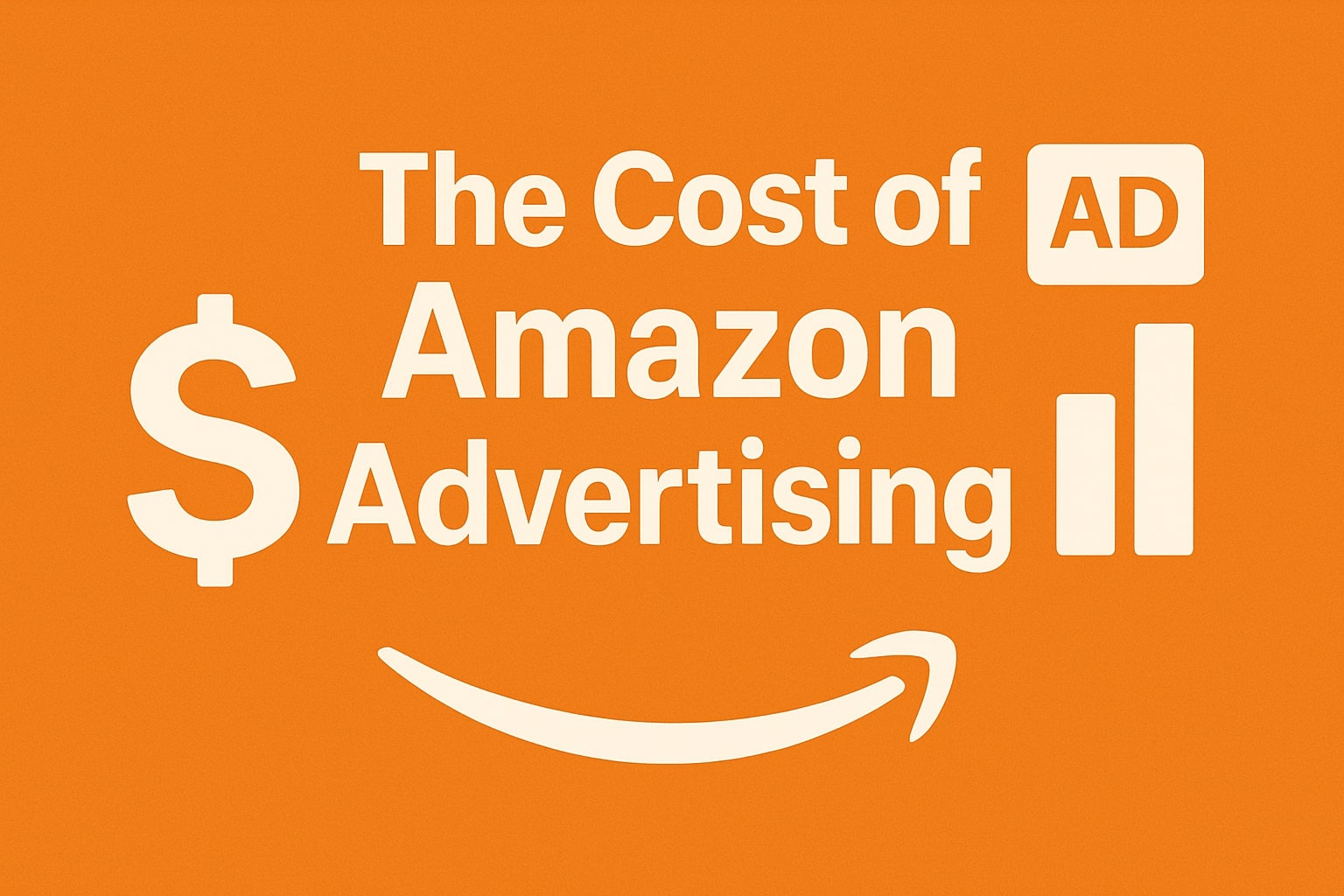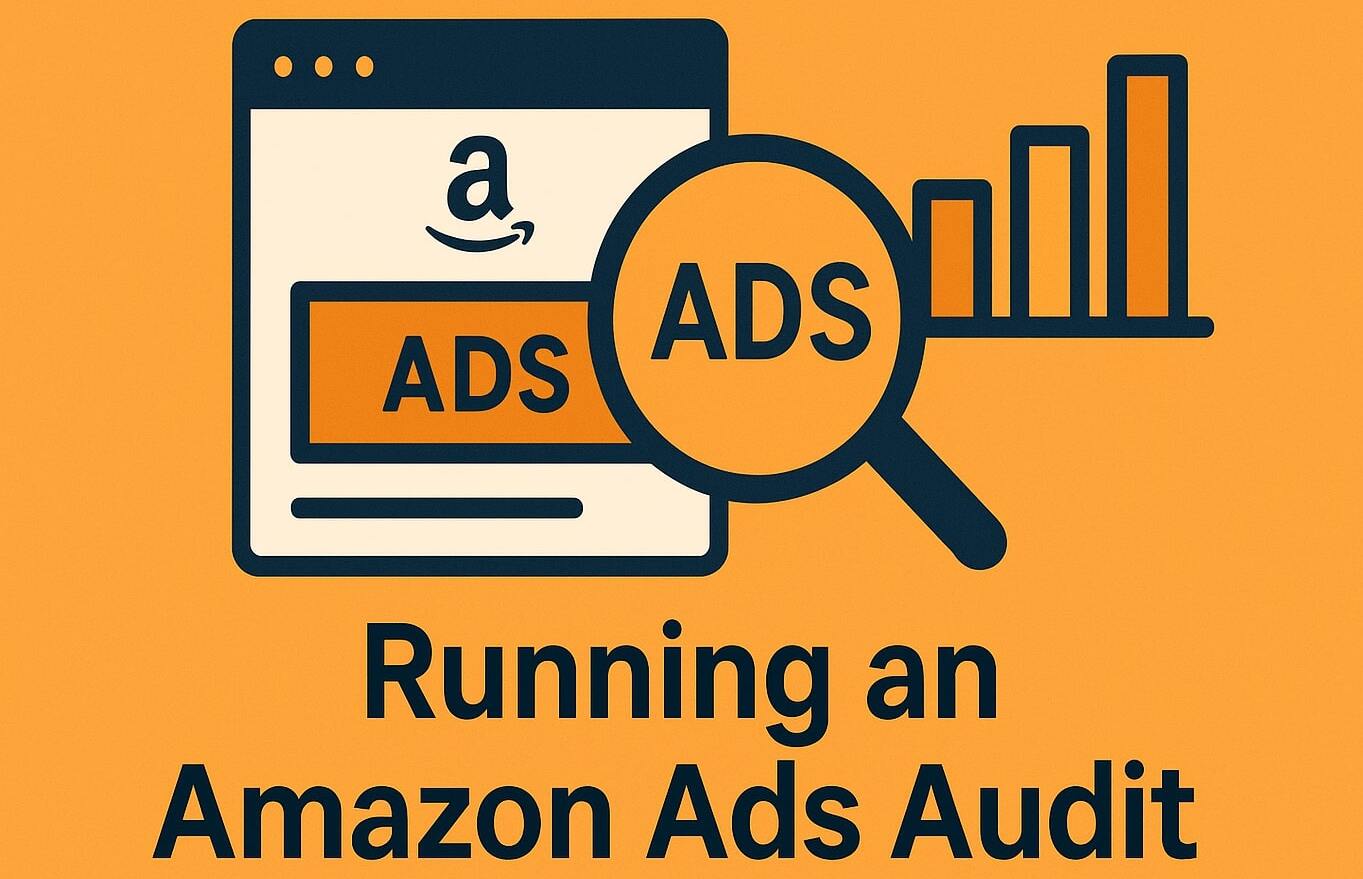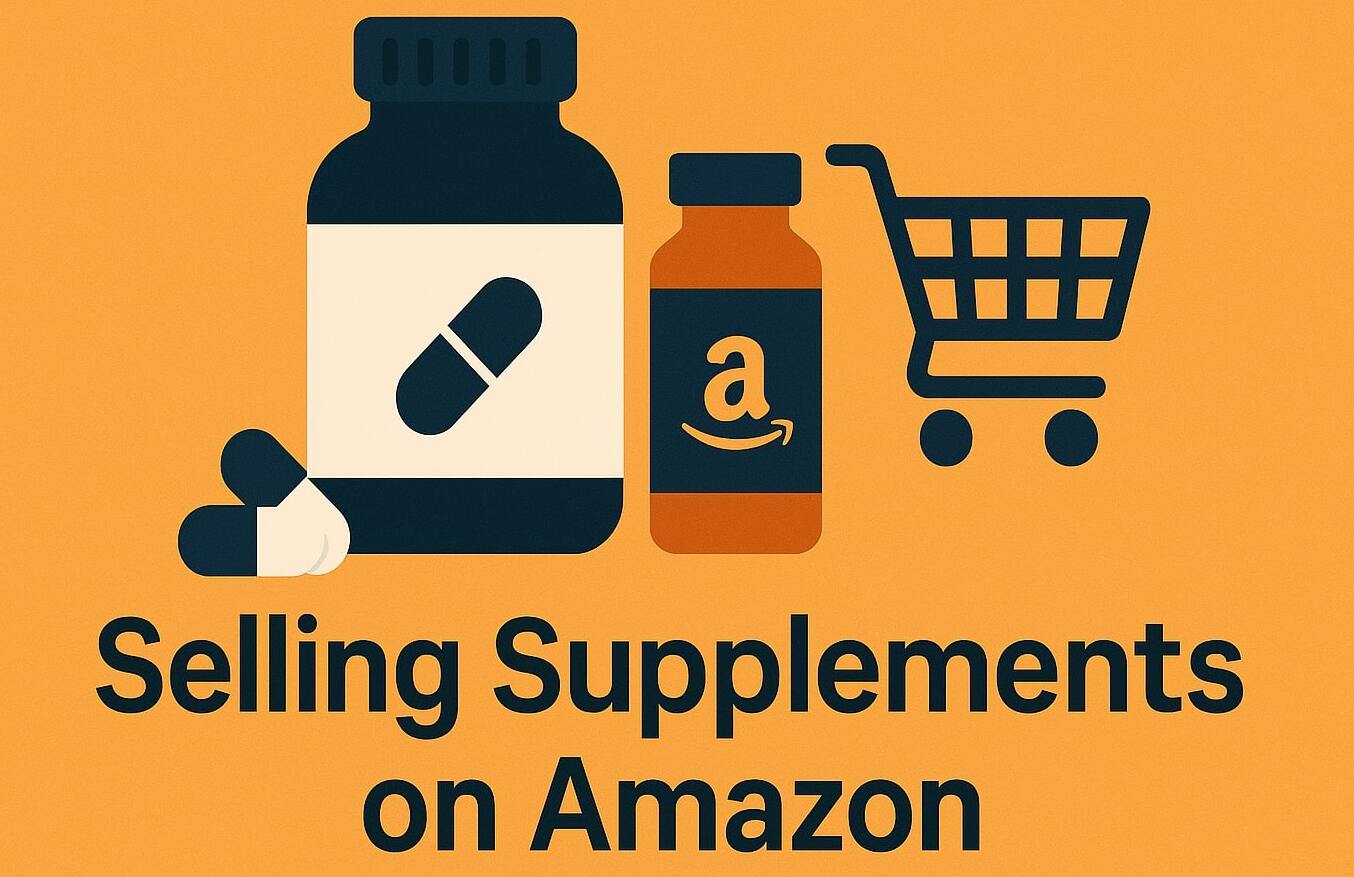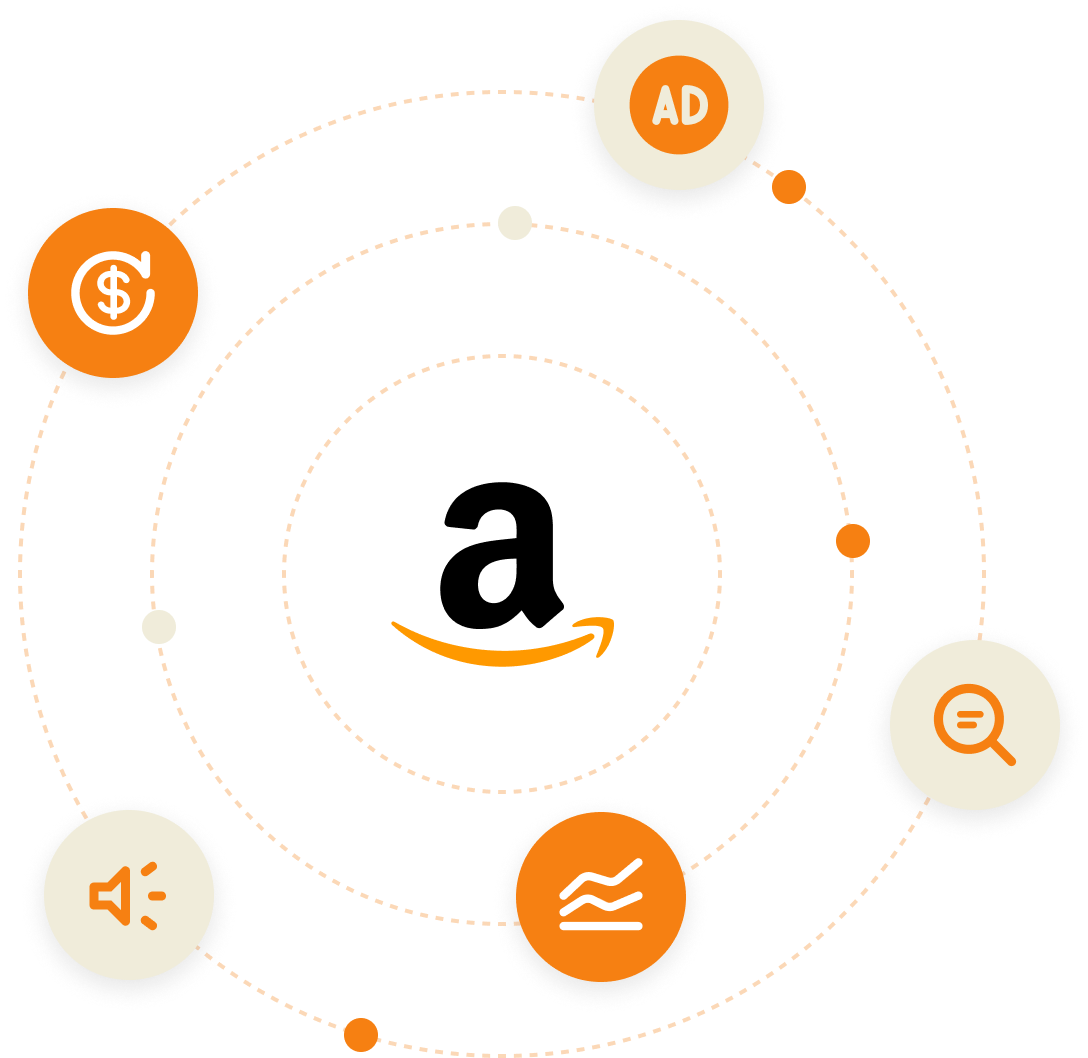Amazon’s advertising game is bigger than ever, and if you’re selling on the platform, you need to get in the game. In 2024 global sales on Amazon hit almost $640 billion and generated a massive $56.2 billion in advertising revenue – a 20% increase from the previous year. That’s a ton of money being poured into ads, which means more competition, increased ad costs and higher stakes for third-party sellers.
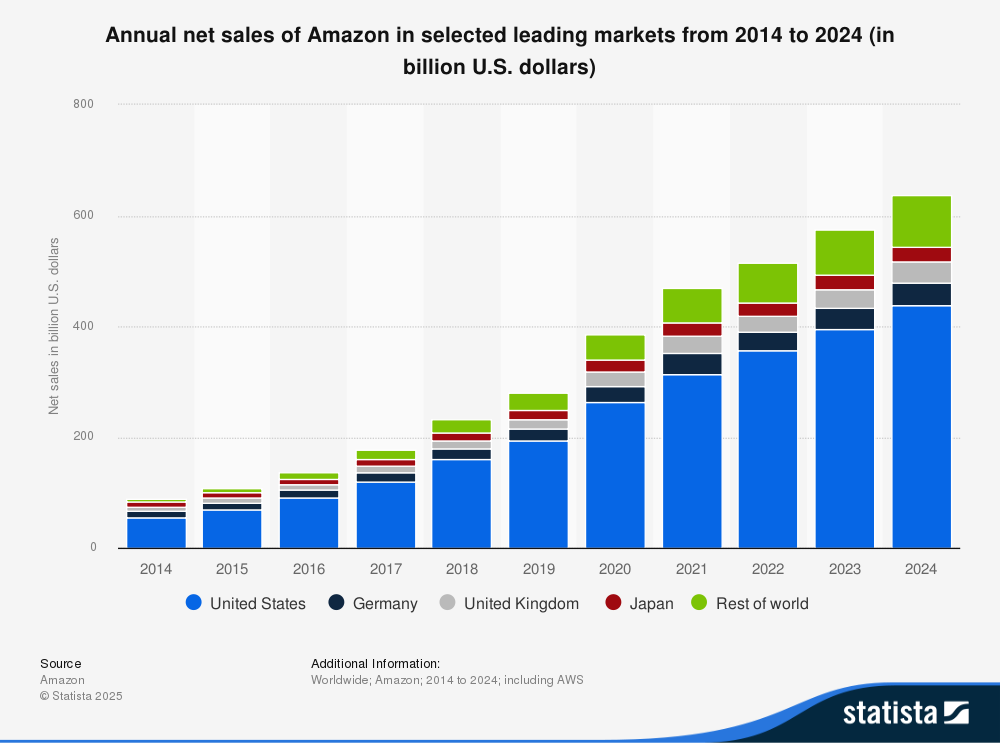
But here’s the problem: a lot of advertisers struggle to see real return on investment (ROI) from their campaigns. They’re spending cash, but they’re not always getting the results they expect.
To successfully run ads on Amazon, you need to understand how they work and how much they cost. Amazon’s advertising system operates on a pay-per-click (PPC) model, meaning you bid on keywords or product targets to get your ads shown. The higher the bid, the better your chances of securing top placements, like the top of search (TOS) results or on a competitor’s product page. It sounds simple, but winning in Amazon advertising isn’t just about bidding high – it’s about bidding smart to ensure you’re not overspending and cutting into your profits.
That’s exactly what this guide is here to break down. By the end, you’ll understand how much Amazon PPC costs, what factors influence your advertising spend, and how to make the most of your budget to drive profitable results.
Is Your Amazon Store Reaching Its Full Potential?
Discover hidden opportunities, reduce wasted spend, and boost your sales with a free expert audit.
Our team will analyze your listings, ad performance, and overall account health to uncover exactly what’s working—and what’s holding you back. You’ll get a tailored blueprint to scale smarter, not harder.
Get a Free AuditWhat are the different types of Amazon Ads?
Amazon ads aren’t one-size-fits-all. The type of ad you run depends on your marketing objective – whether it’s getting more sales, building brand awareness, or bringing back shoppers who previously purchased or looked at your product but didn’t buy. To access Amazon’s advertising platform you need a professional seller account. Let’s take a closer look at the three primary ad types and how they work.
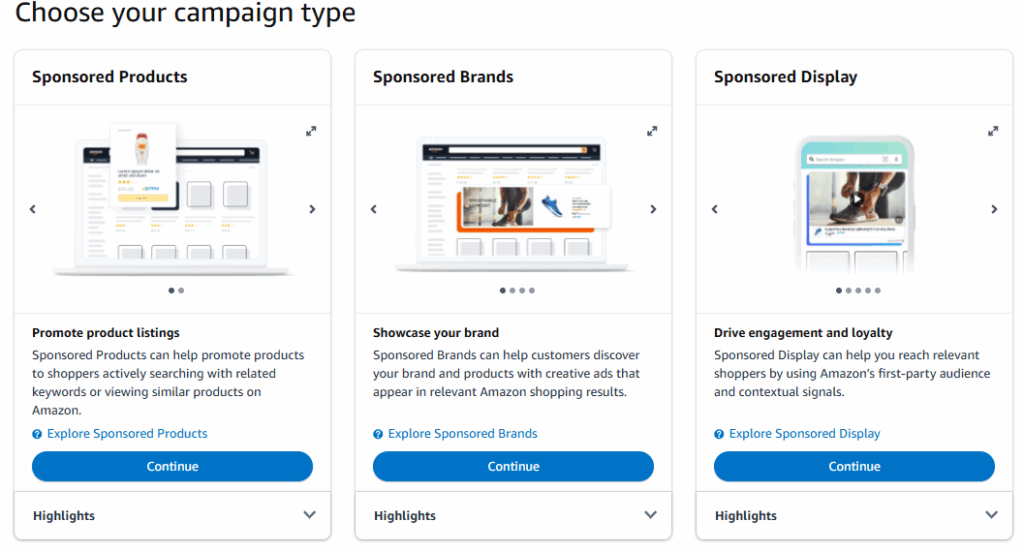
Sponsored Products Ads
Sponsored Products are the most popular ad type and the most effective Amazon ad type for driving sales. These product ads appear in search results and on product detail pages, blending in naturally with organic listings – most shoppers don’t even realize they’re ads. They operate on a cost-per-click (CPC) model, meaning you only pay when someone clicks on your ad.
Sponsored Products campaigns are primarily keyword-based, meaning you bid on search terms relevant to your product. However, they also support product and category targeting, allowing you to place your ad on competing product pages. This is an effective strategy for stealing traffic from competitors or cross-selling related products in your own catalog.
Best for: Increasing product visibility, driving conversions, and competing directly with similar products.
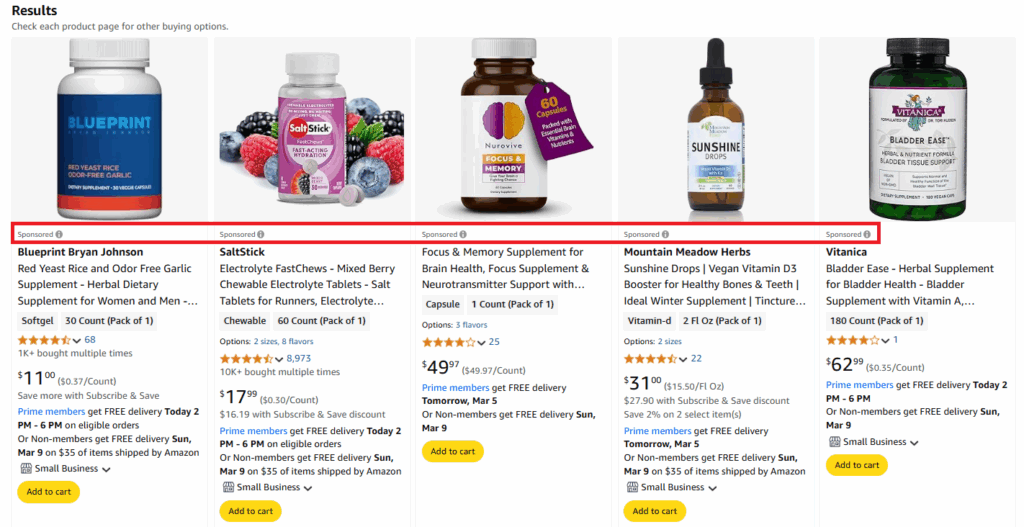
Sponsored Brand Ads
Sponsored Brands are gaining in popularity among brand-registered sellers. They run on a CPC model, but they also offer a cost-per-viewable-impression (vCPM) option, allowing you to optimize for brand awareness rather than just clicks.
Like sponsored products, these ads target keywords and appear in high visibility placements in search results and on product detail pages. Sponsored Brands campaigns can be set up in two main formats: Product Collection ads, which feature multiple products, and Video ads, which highlight a single product with engaging video content.
Best for: Building brand recognition, increasing visibility across search results, and driving traffic to product landing pages or your Amazon Store.

Sponsored Display Ads
Sponsored Display is Amazon’s retargeting ad solution, designed to help you re-engage with shoppers who have previously viewed/purchased your products or your competitors products. Unlike Sponsored Products and Sponsored Brands, which are search-based, Sponsored Display ads appear on Amazon as well as off Amazon such as on third-party websites and apps.
These ads use audience targeting rather than just keywords or products, meaning they can reach shoppers based on their behavior, like past browsing history or product interest. You can learn more about Sponsored Display Ads in detail here.
Best for: Retargeting potential buyers and expanding reach beyond Amazon.


Average Spend Distribution by Ad Type
Allocating your advertising budget effectively requires understanding how spend is typically distributed across these ad types. According to BidX, below is a table illustrating the average spend ratio for each ad type in 2023:
| Ad Type | Average Spend Ratio |
|---|---|
| Sponsored Products | 79.4% |
| Sponsored Brands | 12.7% |
| Sponsored Display | 4.9% |
This distribution indicates that the majority of advertising budgets are invested in Amazon Sponsored Products, reflecting their effectiveness in driving direct sales. However, incorporating Sponsored Brands and Sponsored Display ads can provide additional benefits, such as enhanced brand visibility and customer retargeting, contributing to a well-rounded advertising strategy.
What is the Average CPC for Amazon Ads in 2025?
The average cost-per-click on Amazon in 2024 was $0.97. This number fluctuates based on factors like competition, product category, and bidding strategy.
Understanding the average CPC for each Amazon ad type is key to setting a realistic budget and making the most of your ad spend. According to My Real Profit, below is a breakdown of the average CPC for each ad type to help you plan your budget effectively.
| Ad Type | Average CPC |
|---|---|
| Sponsored Products | $0.81 – $1.20 |
| Sponsored Brands | $1.50 – $2.50 |
| Sponsored Display | $0.70 – $2.00 |
Factors that Influence the Cost of Advertising
If you’re running Amazon PPC, you need to know why your costs are what they are otherwise, you’re just throwing money away. Here’s what impacts how much you’ll pay for clicks and impressions:
1. The Type of Ad You’re Running
Not all ads are priced the same. Sponsored Products usually have the lowest CPCs, Sponsored Brands typically cost more because they’re premium ad placements like top-of-search banners, while Sponsored Display can be CPC or CPM-based, meaning you might pay per click or per thousand impressions.
2. Your Bidding Strategy
Amazon PPC runs on a bidding system – you tell Amazon how much you’re willing to pay per click, and they decide where your ad shows up. If you’re bidding aggressively, expect to pay more. If you go too low, your ads might barely get seen. The balance is finding that sweet spot between winning placements and not overpaying.
3. Keyword Competition
Relevant keywords are like prime real estate – everyone wants them, so they cost more. If you’re targeting high-traffic, competitive keywords eg. electrolyte powder, be ready to spend big. But long-tail, niche keywords such as sugar free electrolyte powder, usually have lower CPCs and can still have a good conversion rate.
4. Your Product Category
The type of product can have different costs of advertising. If you’re in high competition categories like supplements or skin care, expect CPCs to be well over $1 per click. Meanwhile, less competitive spaces, like handmade crafts, can get clicks for under $0.50.
5. Targeting Options
How you target shoppers also changes what you pay. Broad keyword campaigns and automatic targeting cast a wide net but can lead to wasted spend. Manual targeting with exact and phrase match is usually more efficient but requires more fine-tuning. Retargeting audiences with Sponsored Display? That’s another game altogether, and you might be paying per impression instead of per click.
7. Seasonal Demand & Market Trends
The cost of advertising is dynamic, it can shift depending on demand. You can expect CPCs to spike around Q4, because everyone is bidding like crazy for holiday traffic, and then dip during slower months. If you’re running ads during Prime Day, Black Friday, or Cyber Monday, be ready to increase your bids or risk losing visibility.
7. Campaign Budget
Your budget directly impacts your CPC strategy. If you have a smaller budget, you’ll need to adjust your bids to maximize your ad exposure without burning through your funds too quickly. For example, setting a higher bid means you’ll win more competitive placements, but you’ll also exhaust your budget faster. On the other hand, a lower bid allows you to stretch your budget further, getting more clicks but potentially at a lower placement rank. Striking the right balance is key – you need to bid high enough to stay competitive while ensuring you’re not overpaying for each click and depleting your budget too soon.
For example: let’s say you have daily budget of $200 to spend on a PPC campaign—if you bid $1 per click, you can get 200 clicks. But if you set your bid at $2.00 per click, you’ll only get 100 clicks before your budget runs out.
Types of Campaign Bidding Strategies
For Sponsored Product campaigns, Amazon provides different bidding strategies as an option for sellers, helping you control your advertising spend while maximizing product visibility. Here’s a brief overview of each and when you should use them:
- Dynamic Bids – Up and Down: Amazon increases your bids when your ad may be more likely to convert to a sale and decreases them when it’s less likely. This option is ideal if you are looking for a more aggressive optimization and are willing to pay more for better ad placement.
- Dynamic Bids – Down Only: Amazon reduces your bid when it predicts a lower chance of conversion. This is best if you are looking for better budget control and are wanting to minimize wasted ad spend.
- Fixed Bids: Your bids stay exactly as you set them, without Amazon adjusting them based on conversion likelihood. This is useful when testing a consistent bidding strategy or maintaining tight control over costs.
- Rule-Based Bidding: This strategy allows you to set custom rules for bid adjustments based on specific goals, such as targeting a certain ACoS (Advertising Cost of Sales). It is more useful for advertisers who have gained some experience with Amazon Ads and want greater control over their bid adjustments based on data-driven insights. To be eligible for rule-based bidding, a campaign must have been running for at least 10 days and have recorded at least 10 conversions in the past 30 days.
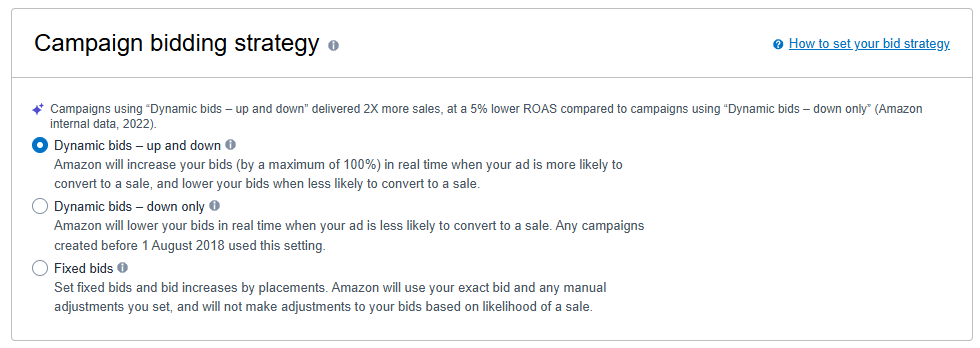
Choosing the right bidding strategy depends on your campaign goals, risk tolerance, and your budget. Consistently testing, monitoring and optimtimizing campaigns can help determine the most effective approach for your brand.
How to setup your Ad Campaigns
What should my daily advertising budget be?
Your marketing budget depends on your advertising goals, competition, and product margins. Amazon recommends starting with at least $10 per day per campaign, but individual products or more competitive niches may require a minimum spend of $50 or more to be effective. A higher budget allows for more impressions and data collection, helping you refine your strategy over time. If you’re working with a smaller budget, prioritize high-intent keywords and optimize your bids to maximize efficiency.
How do keyword bids work?
When you bid on a keyword in Amazon ads, you’re entering a real-time CPC auction against other advertisers targeting the same keyword. This auction determines which ads will appear in search results and in what order.
Amazon’s bidding system is based on a modified second-price auction, meaning you don’t necessarily pay your full bid amount – just $0.01 more than the next highest bidder. This means the highest bid doesn’t always win. If your ad is more relevant than a competitor’s, you may win a higher placement while paying less per click.
For example, if your keyword bid is $1.00 and your competitor bids $0.75, you might expect to pay $0.76 per click. But if your ad has a higher relevance score, Amazon may discount your CPC further, meaning you could pay even less while still outranking your competitor.
Amazon provides recommended bid ranges to help guide your keyword bidding strategy, but blindly bidding high won’t guarantee success. Instead, a combination of competitive bidding and ad relevance is the key to securing top placements at the lowest cost.
How to estimate your cost-per-click
Your CPC is determined by competition and your bid strategy – the more advertisers bidding on a keyword, the higher the cost. Generally, Amazon’s average cost per click is around $0.97, but it can be much higher in competitive categories. If your bids are too low, your ads may not show, while bids that are too high can drain your budget fast. Finding the right balance is key to maintaining profitability.
A good starting point is Amazon’s Suggested Bids, which gives you an idea of what others in your niche are paying. But don’t just set it and forget it, regularly monitor campaign performance and adjust bids based on key metrics like click-through rate (CTR) and conversion rate (CVR). If a keyword is converting well, increasing the bid can help you dominate more placements. If it’s draining your budget with no returns, lowering the bid or pausing it makes more sense. Tools like Jungle Scout and other PPC software can also help by showing median CPCs for different keywords, giving you better insight into where your bid should be to stay competitive.
What is a good ROI in Amazon Ads?
A good return on investment (ROI) in Amazon PPC depends on several factors, including product category, competition, and overall business goals. ROI is typically measured through ACoS (Advertising Cost of Sales) and TACoS (Total Advertising Cost of Sales). These are key metrics which give insight into how efficiently your advertising spend is generating revenue.
ACoS tells you the percentage of your advertising revenue spent on ads. The formula is:

A lower ACoS means your ads are more cost-efficient, with 20-30% being a common target range for many sellers. However, acceptable ACoS varies by category – some highly competitive niches might see profitable ACoS closer to 35-40%, while lower-margin products might require a much lower ACoS to stay profitable.
TACoS, on the other hand, looks at how much your advertising spend contributes to total sales revenue, including organic product sales:

A lower TACoS over time indicates that your organic sales are growing, meaning your ads are helping improve rankings and long-term profitability. If your TACoS is high and not decreasing, it could mean your ads are driving sales but not improving organic rank, which might signal the need for better product listing optimization or keyword adjustments.
It’s important to look beyond ACoS and TACoS when evaluating ROI. Your product price, profit margins, and conversion rate all play a role in determining what a “good” ROI looks like for you. For example, a higher ACoS might be acceptable if it leads to strong organic sales growth, especially for new product launches or aggressive brand awareness campaigns. On the flip side, if your ad costs are eating into your profit margins too much, you may need to refine your bidding strategy, optimize your listings, or focus on better-performing keywords to improve ROI.
Ultimately, the best ROI in Amazon Ads is one that aligns with your business objectives. Whether that’s profitability, market dominance, or scaling sales volume. Tracking both ACoS and TACoS regularly gives you the full picture of how your ads are working for your business.
How to Optimise Ads to Lower your CPC?
Amazon ads aren’t just about who bids the highest. They’re about who bids the smartest. If you’re overpaying for clicks, you’re wasting money, and if your bids are too low, you’re not getting the visibility you need. Your advertising goal is to reduce CPC while maintaining, or even increasing, conversions. Here’s how to do it:
1. Dial In Your Keyword Targeting
If you’re bidding on broad, high-competition keywords, you’re probably paying way more than you should. Instead of burning through your budget on generic terms, focus on long-tail, high-intent low-competition keywords. These are cheaper and convert better because they target shoppers who already know what they want.
Pro Tip: Add negative keywords for any expensive, non-converting keywords from your Amazon PPC campaigns so you’re not wasting money on irrelevant clicks.
2. Run Auto Campaigns to Discover Cheap, High-Converting Keywords
Amazon’s Automatic campaigns are great for keyword discovery, but don’t just let them run wild. Set a low bid, monitor for keywords that bring in conversions at a low CPC, and then launch those into manual campaigns where you can control the bids.
3. Adjust Bids by Placement – Stop Overpaying for Top of Search
Amazon lets you adjust bids for different placements (Top of Search, Product Pages, Rest of Search). Many sellers blindly increase Top of Search bids, but you don’t always need to be number 1.
Test this: Lower your Top of Search bid multiplier and increase bids by placement for Product Pages. Sometimes, you’ll get cheaper CPCs and still solid conversions by showing up on competitors’ listings.
4. Optimize Your Listing – Because a Bad Listing Kills Your CPC
If your listing isn’t optimized, you’re paying for clicks that don’t convert—which means you’re wasting ad spend with little return.. A high CPC doesn’t matter if your conversion rate is low. Make sure you have:
- High-quality images & A+ Content
- A compelling and relevant keyword rich title & bullet points
- Competitive pricing
- Strong reviews
Your ads are only as good as your product listing. Aim for a conversion rate above 10%.
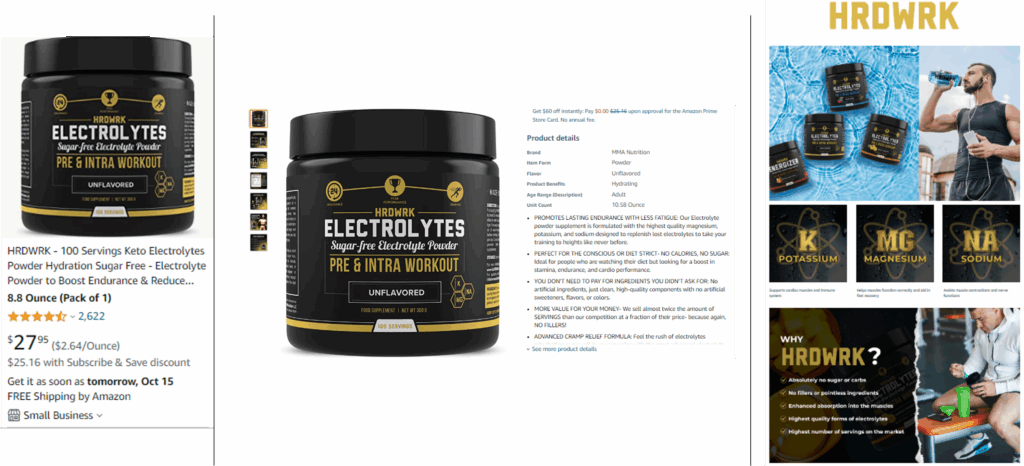
5. Use Exact & Phrase Match Instead of Broad Match
Broad match keywords burn through budget fast because Amazon shows your ads for way too many unrelated searches. Instead, use Exact and Phrase match to control what your ad is actually showing up for and reduce wasted spend.
Pro tips:
Use Broad Match Modifiers (with +keywords) instead of normal Broad Match to keep some control.
Set higher bids for Exact Match since it’s more targeted and lowers wasted ad spend.
6. Leverage Dayparting – Stop Running Ads When No One’s Buying
Amazon lets you adjust your bids throughout the day, but most sellers ignore this completely. If you check your reports and see that your conversion rate drops after 10 PM, why are you still bidding the same at night?
Test This: Lower your bids or pause ads during low-converting hours. Allocate that budget to peak buying times to improve efficiency and reduce CPC waste.
7. Regularly Optimize & Cut the Fat
Don’t just “set and forget” your ads. Review your Amazon PPC campaigns every few days and make adjustments:
- Pause high-spend, low-converting keywords
- Lower bids on expensive, underperforming keywords
- Increase bids on low CPC, high-converting keywords
- Negate irrelevant/poor performing keywords from campaigns

Struggling with Amazon Ad Costs? Get Expert Support
Winning with Amazon advertising isn’t just about spending more – it’s about understanding your costs and making every dollar count.
Trivium’s PPC experts are here to help. At Trivium, we don’t just guess – we optimize based on data. Whether you’re struggling with high CPCs, wasted ad spend, or just don’t have the time to manage PPC yourself, we’ve got you covered.
And if you want to master Amazon PPC and take control of your ad costs? Check out Trivium’s PPC University, where you’ll learn everything from bidding strategies to advanced cost optimization techniques. Get expert insights, proven strategies, and real-world tactics to make your ad spend work smarter, not harder.
Struggling to Scale on Amazon?
Get a free expert audit and uncover quick wins to boost sales and cut ad waste.
Get a Free AuditFAQs
Amazon advertising costs are determined by your CPC (cost per click) multiplied by the number of clicks your ad receives. For example, if your CPC is $1.10 and you get 100 clicks, your total ad spend would be $110. However, for ads that run on a cost-per-thousand impressions (CPM) model, costs are based on the number of times your ad is seen rather than clicked.
The average cost of an advertising campaign varies depending on budget, bid strategy, keyword competition, and product category. Some advertisers start with as little as a $100 monthly budget, while larger brands have a budget allocation of tens of thousands to aggressively scale.
Your Amazon ad costs depend on the ad type, daily budget, targeting strategy, and keyword bids and without proper optimization, even a $10 daily budget can be wasted due to poor targeting, pricing, or listing quality.
A 100% ACoS (Advertising Cost of Sales) means you’re spending as much on ads as you’re making in sales. While this is usually not ideal for profitability, it doesn’t automatically mean your campaign performance is failing. Advertised sales contribute to organic ranking on Amazon, which can lead to higher organic sales over time. If your ads are boosting your ranking and generating more organic sales, a higher ACoS might still be profitable in the long run. Instead of just looking at ACoS, consider Total Advertising Cost of Sales (TACoS). This metric measures your ad spend relative to total revenue (both organic and paid sales). If your TACoS is decreasing while your total sales are increasing, it means your organic sales are improving, making your advertising efforts worthwhile even at a higher ACoS.
Amazon advertising is based on a dynamic bidding system, meaning you’re competing with other sellers for ad placements. Most ads run on a pay-per-click (PPC) model, meaning you only pay when someone clicks your ad. However, some ads, like Sponsored Display use a cost-per-thousand impressions (CPM) model, where you’re cost of ads is based on how many times your ad is seen, rather than clicked.
Amazon charges cost of advertising in two ways: it can be deducted directly from your selling account balance or charged to a payment method on your Seller Central account. Billing occurs periodically or when your ad spend reaches a billing threshold set by Amazon.
While Amazon doesn’t enforce a strict minimum daily budget for advertising campaigns, they recommend starting with at least $10 per campaign to ensure sufficient data collection and optimization. However, daily budgets among sellers vary widely, often influenced by individual goals, product categories, and competition levels. Some Amazon sellers start with budgets as low as $5 per day, while others allocate $100 or more daily to gather more data and potentially accelerate results.

